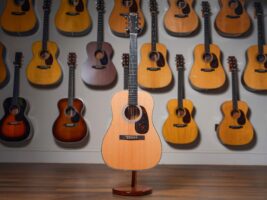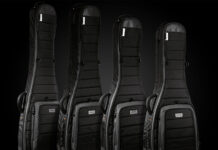
How Martin’s Oʻahu HG-28 sheds light on the hidden history of the Dreadnought
Ad feature with Martin Guitar
The dreadnought acoustic guitar has long been associated with country and folk music. But did you know that the first dreadnoughts made by Martin under the Ditson brand name were originally intended for music from Hawaii?
In fact, there is a strong argument that modern society owes a significant cultural debt to this tiny group of islands, and should be celebrated. This is certainly a position held by C.F. Martin IV – former Martin guitar CEO, current Executive Chairman of the iconic guitar brand, and the man with a name that should indicate that he very much knows what he’s talking about.
Chris Martin has been heavily involved in the new Martin Oʻahu sub-brand – and its debut instrument, the HG-28. The HG-28 is the sort of guitar to make dreadnought fans sit up and take notice – a 14-fret instrument with a shorter 24.9-inch scale length, a Sitka spruce top, and Hawaiian koa on the back and sides.
You can see a fair bit of of Dread DNA in here, and that’s by design – as Chris himself explained in the latest Martin Journal, that is by design. Modern guitar in general would be a very different place without the impact of Hawaiian music.
After all, how many times have we read that resonators, lap steels, and electric guitars were originally invented for Hawaiian music? It’s a fact that many players tend to gloss over, but it remains a fact.
Unconventional Origins
The specs listed above are rather unusual for a Martin guitar, but that’s because the whole concept for this instrument actually came from a vintage Gibson – and one that you’ve almost certainly never heard of.
The HG-20 is a superbly improbable guitar – it sports both an internal resonating chamber and no less than two sets of f-holes in its top. The guitar was, like the original Ditson Dreadnought, designed for Hawaiian music.
When browsing an auction one day, Chris Martin IV spotted the guitar and instantly recognised that this bizarre guitar’s outline was remarkably similar to a slope-shouldered dreadnought.
This revelation led to an intense period of research in the company’s archives and ultimately led to the creation of the HG-28 – a guitar that imagines itself as the Hawaiian ‘missing link’ in the evolution of the Dreadnought between the commercial failure of the Ditson Dread to the all-conquering 14-fret Martin-branded beast that would come along 17 years later.
Uke Can Do It
Another instrument that had a massive influence on the Martin Company is the ukulele. In fact, during the dark financial times of the 1920s, the Martin Company survived thanks to the thousands of ukuleles they were able to make and sell.
Koa was a common wood choice for the ukulele – an instrument which saw a huge spike in popularity following the Panama Pacific International Exposition of 1915. This was arguably the point at which the world fell in love with Hawaiian culture and it would not be the last time that the tiny ukulele would have a significant effect on popular music around the world.
Martin pioneered the use of koa for steel string guitars in the 1920s and the wood, which only grows on the Hawaiian islands. In recent years, koa has again become very popular with players looking for something different to mahogany or rosewood – but the HG-28 is another way to demonstrate the brand’s early engagement with what feels like a very modern concept.
The gently slope-shouldered body of the Oʻahu HG-28 is slightly slimmer than a regulation dreadnought. In fact, it’s the same depth as a Martin 000, making it very comfortable indeed for the seated player. The neck features Martin’s low oval High Performance taper with 14 frets to the body, while the 13/4-inch nut width means there’s plenty of space for the fingerstyle player, too
There are plenty of other nice little touches on the HG-28 that make it feel a little different to the regular line Martin – the herringbone purfling, the colourful palm-adorned internal label, and of course the word ʻOʻahu’ – note the correctly oriented apostrophe! – sitting proudly on the headstock beneath the iconic Martin logo.
Because the HG-28 is not just one guitar – it’s the start of a range. Already, the Oʻahu sub-brand has absorbed an existing Martin tribute to the huge impact of Hawaiian guitar culture – the Custom K-1 Major Kealakai
Kealakai was a giant of Hawaiian music, who was the conductor for the Royal Hawaiian Band. The custom guitar made for him by Martin in 1916 – recreated in the K-1 – was itself a direct forebear of what became the dreadnought we now know and love.
The Oʻahu HG-28 is a fitting tribute to the influence of Hawaiian culture on modern music, and a great and interesting addition to the Martin line. If you’ve ever been tempted by the sound of a classic dread but have been put off by the size, this could very well be the perfect guitar for you.
Find out more about the Oʻahu range at martinguitar.com.
The post How Martin’s Oʻahu HG-28 sheds light on the hidden history of the Dreadnought appeared first on Guitar.com | All Things Guitar.
Source: www.guitar-bass.net












